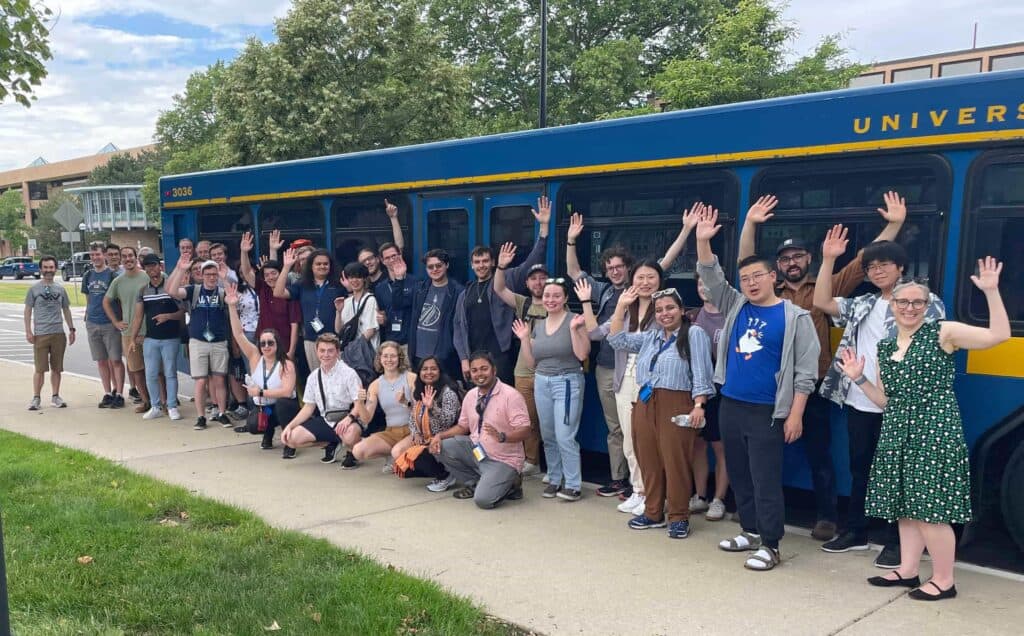
NERS astrophysics center hosts high-energy-density physics summer school
Participants learned about the foundational principles and advanced concepts of high-energy-density physics from U-M faculty.

Participants learned about the foundational principles and advanced concepts of high-energy-density physics from U-M faculty.
The High Energy Density (HED) Summer School, hosted by the Center for High Energy Density Laboratory Astrophysics Research (CHEDAR) at the University of Michigan, offered an opportunity for participants to delve into the rapidly advancing field of high-energy-density (HED) physics. This field, essential to inertial fusion research, astrophysics, and various fundamental studies, leverages modern devices to create extreme pressures and temperatures, pushing the boundaries of scientific understanding.
This year’s summer school was structured into two components: a high-level virtual segment held from June 3–7, and an in-depth, in-person session from June 17–21 on the University’s Ann Arbor campus. The virtual component, presented via Zoom, attracted over 100 registrants, offering a series of ten two-hour lectures that provided foundational knowledge in HED physics. These lectures were delivered by U-M faculty members, including NERS Professors Carolyn Kuranz, Alec Thomas, Louise Willingale, Ryan McBride, and Scott Baalrud, and Professor Eric Johnsen from Mechanical Engineering. NERS postdoctoral fellow Dr. Heath LeFevre, and graduate student Sonya Dick also lectured.

The in-person segment at Ann Arbor brought together 40 participants from across the globe for an intensive week of advanced lectures and hands-on group projects. This segment included lectures on HED Laboratory Conditions, HED Diagnostics, Radiation Hydrodynamics, Laboratory Astrophysics, and advanced topics in Shocks and Instabilities. Participants also presented group projects, proposing HED research initiatives at various HED facilities. These projects fostered practical experience in proposal planning and writing, covering experimental goals, motivations, plans, and resource requirements, including targets, diagnostics, and simulations. Examples of proposals for facilities such as Omega, NIF, the Z machine, ZEUS, and LaserNetUS were discussed.
“I thought the summer school was a really interesting introduction to HED physics,” said Jarett LeVan, an Engineering Physics undergraduate student. “It did a great job of covering both the fundamentals and discussing active areas of research. I would highly recommend it to anyone interested in HED.”
The summer school featured introductions to cutting-edge facilities including the ZEUS, which is funded by the National Science Foundation, and MAIZE, providing participants with insights into current research tools and methodologies. The National Nuclear Security Administration (NNSA) supported travel for U.S. citizens, enhancing accessibility to this vital educational opportunity.
“The summer school was a great success,” said Kuranz. “I’m glad we were able to have students participate both online and in person. It allowed for broad access to the material and give students the opportunity to have meaningful interactions with their peers and CHEDAR faculty.”
Under the leadership of Kuranz, CHEDAR’s mission is to advance the understanding of plasma behavior under extreme conditions. With a $12.5 million grant from the NNSA, CHEDAR’s research spans the movement of radiation through plasmas, plasma mixing, magnetized systems, and innovative measurement techniques. This research is pivotal for both astrophysical phenomena and the stewardship of the U.S. nuclear weapons stockpile.
“I would call the 2024 HEDSS a huge success,” said Ian Freeman, a graduate student at Michigan State University. “We all had a great time, and I really enjoyed my stay. There is a degree of comradery that is associated with staying in the same space for a week that I greatly appreciated.
The High Energy Density Virtual Summer School exemplifies CHEDAR’s commitment to educating and training the next generation of scientists in this dynamic field, fostering a deeper understanding of high-energy-density physics and its applications in both fundamental research and practical implementations.